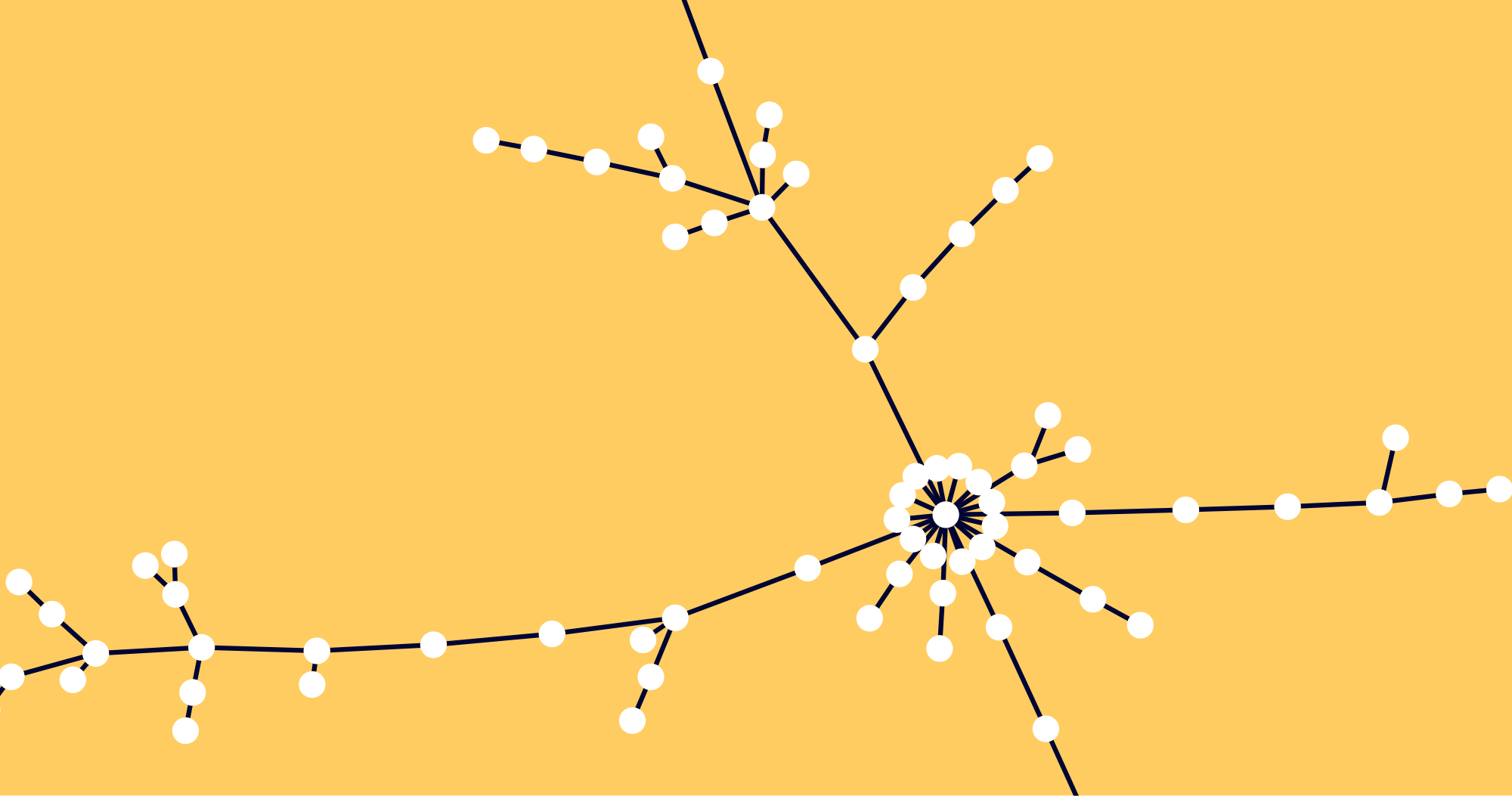Q2 2022 COVID-19 Forecast
Like a weather forecast that tells you when to grab an umbrella on your way out the door, our COVID-19 forecasts help you figure out what epidemic mitigation measures make sense in the future. Forecasts are never perfect, but they increase the odds that you will make the right call.
Our Q2 2022 Forecast presents six-month projections of the COVID-19 pandemic across 19 U.S. cities. These cities include major population centers and important travel hubs, offering a representative snapshot of the entire U.S. epidemic. We calculate the forecast for each city using historical data, including previous cases, hospitalizations, and deaths, as well as the number of partially vaccinated, fully vaccinated, and boosted individuals. The timing of these historical infections and vaccinations are important because they determine the level of immunity in each individual and the susceptibility to infection in the population overall at any point in time.
We also use data from COVID-19 seasonal transmission patterns and changes in human behavioral responses. Importantly, we assume that boosters continue at the current rate of adoption in any area, and we assume that mask mandates have been lifted and people are waning on their social distancing and stay-at-home behaviors. As with all forecasts, uncertainty increases the farther you look ahead. When you examine the following graphs, consider not only the median line, but also the shaded region around it. That region represents 95% of the range of output from our simulations—i.e. the prediction interval—and will give you a sense of the range of possible scenarios.
We’ve chosen to display hospitalizations rather than cases because we think that hospitalizations are a stronger indicator of the current state of the pandemic. Hospitalizations show not only how high a COVID-19 peak will be, but also show the relative severity of the current dominant strain.
You can use these forecasts to plan ahead, whether you’re trying to figure out when and where to host an event, booking a vacation, or wondering what mitigations might be required for the next school term. We are projecting a stretch of low COVID-19 levels through the spring and summer for most locations, with rising infection rates as we enter late summer in southern locations and early fall everywhere else. We expect additional waves in southern cities like Atlanta, Orlando, and Nashville around August, with cases starting to rise in July before falling in September. For non-southern large cities like New York, Chicago, and San Francisco, we are forecasting a very gradual fall wave, with cases slowly increasing through August.
This forecast suggests that most Americans will experience a low-COVID spring and summer and return to most pre-pandemic activities with optional masking. Then, depending on your region, you should keep a sharp eye on how things evolve toward the end of the summer and mask for indoor activities if cases increase for two consecutive weeks in your area.
Scroll down to see COVID-19 forecasts for Atlanta, Austin, Boston, Charlotte, Chicago, Dallas, Denver, Houston, Las Vegas, Nashville, New Orleans, New York, Orlando, Philadelphia, Sacramento, San Antonio, San Diego, San Francisco, and Washington, DC. The peaks in hospitalizations forecasted here could turn out to be lower if a new round of vaccinations is implemented, or the peaks could be higher if a new viral variant emerges.
Atlanta
The city of Atlanta is in the southeast region of our seasonality analysis. From the beginning of March to the beginning of April we expect hospitalizations to be decreasing. Starting in April, we expect hospitalizations to stay the same until June, when they begin increasing again through early August. For the next three months, we expect hospitalizations to average 20 per day. Based on the CDC COVID-19 Community Levels, Atlanta falls into the low transmission category for the next three months.
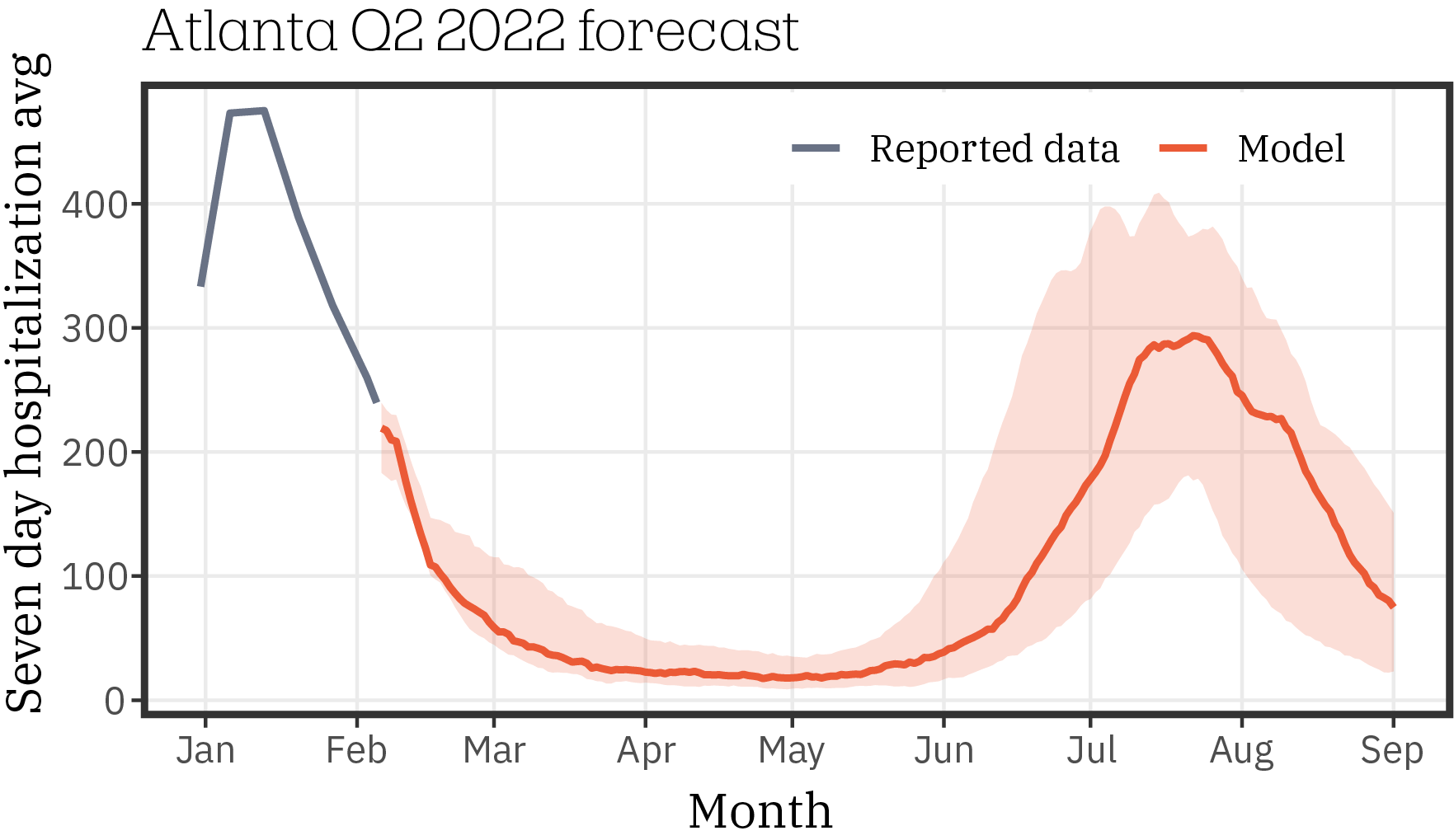
Austin
The city of Austin is in the southwest region of our seasonality analysis. From the beginning of March to early June we expect hospitalizations to stay the same. In June, we expect hospitalizations to begin increasing until late July before decreasing into September. For the next three months, we expect hospitalizations to average 5 per day. Based on the CDC COVID-19 Community Levels, Austin falls into the low transmission category for the next three months.
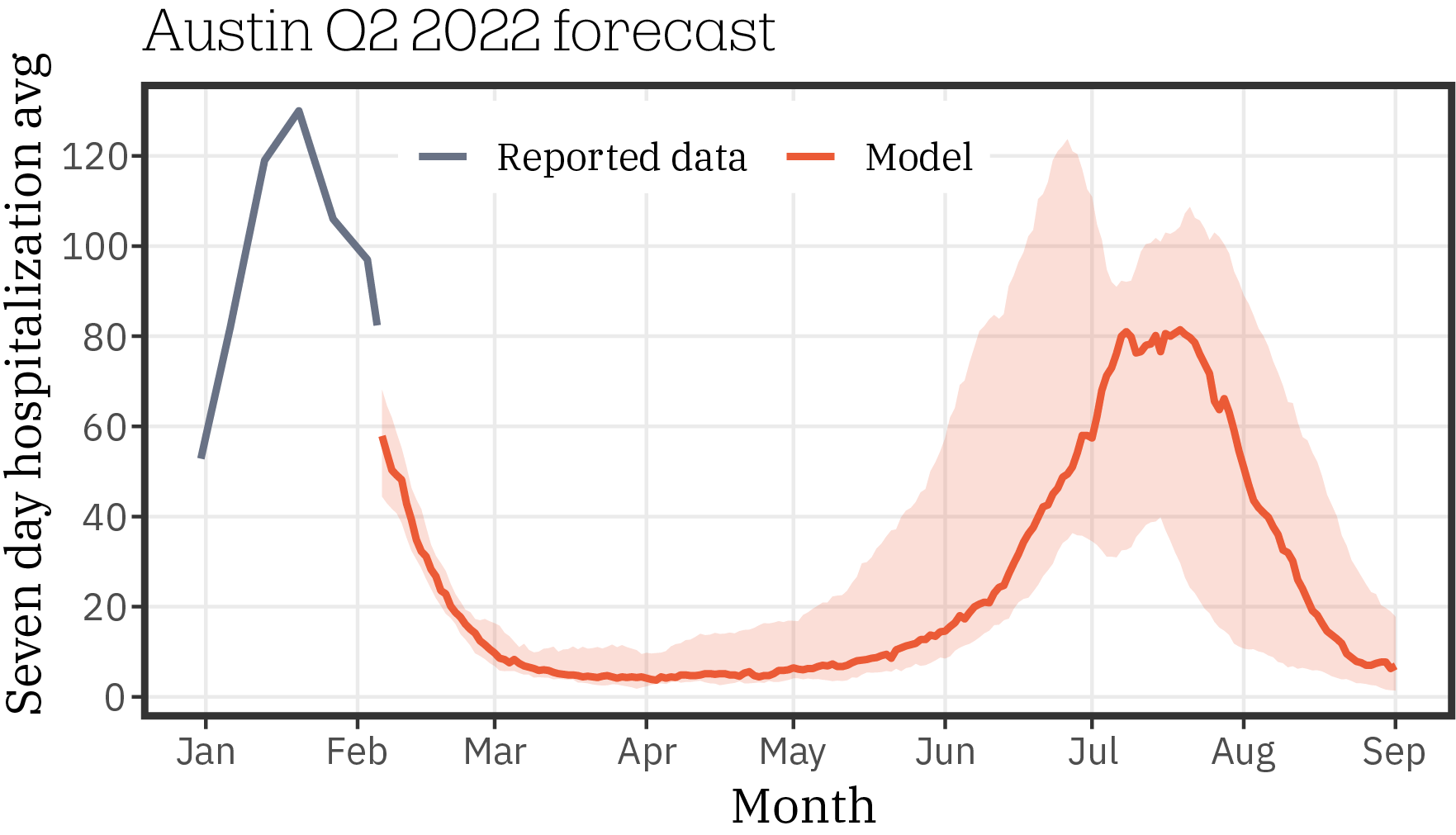
Boston
The city of Boston is in the northeast region of our seasonality analysis. From the beginning of March to the middle of May we expect hospitalizations to stay the same. In June, we expect hospitalizations to begin increasing until the fall. For the next three months, we expect hospitalizations to average 10 per day. Based on the CDC COVID-19 Community Levels, Boston falls into the low transmission category for the next three months.
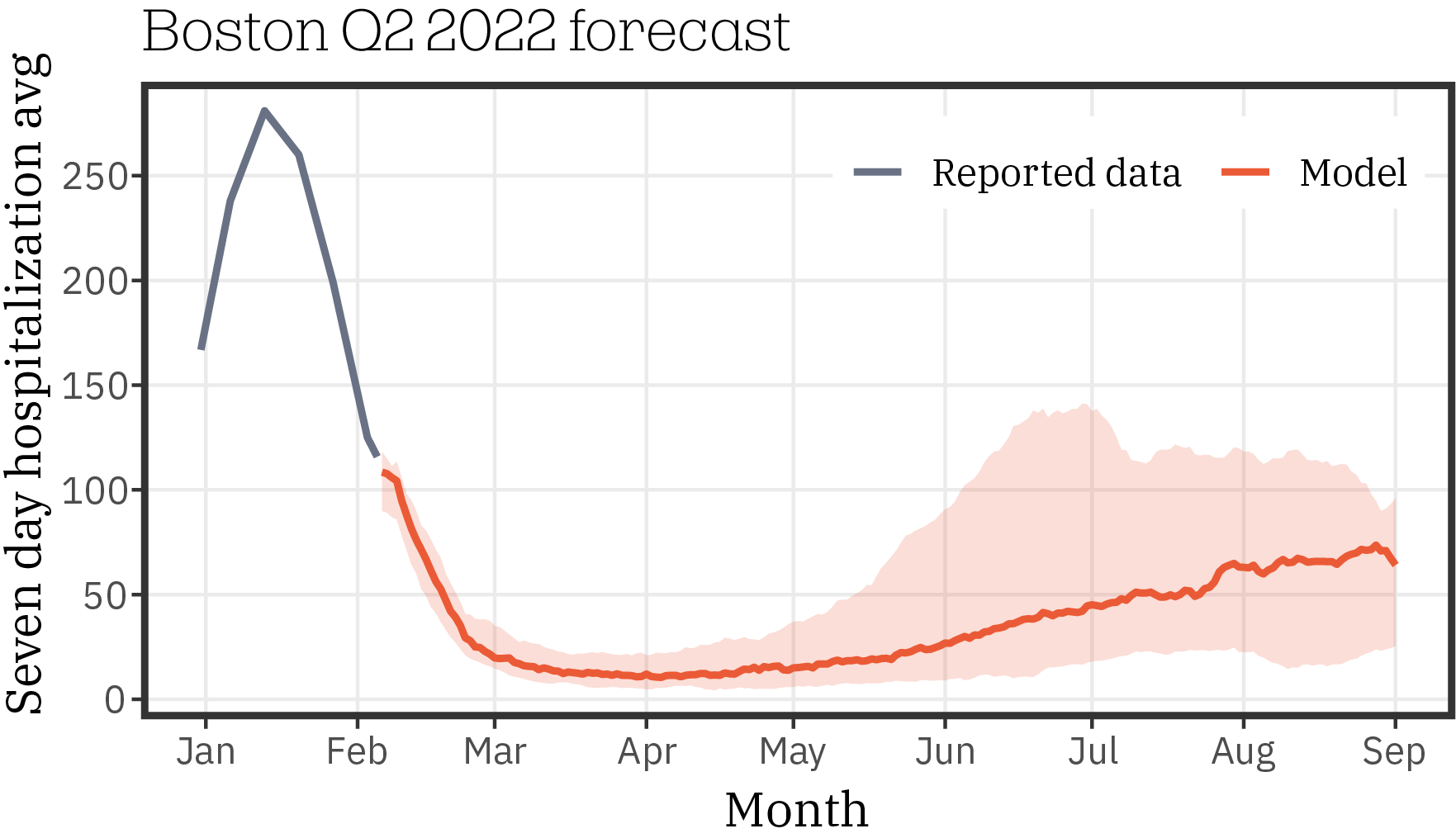
Charlotte
The city of Charlotte is in the southeast region of our seasonality analysis. From the beginning of March to the middle of May we expect hospitalizations to stay the same. In June, we expect hospitalizations to begin increasing until late July, before decreasing through September. For the next three months, we expect hospitalizations to average 2 per day. Based on the CDC COVID-19 Community Levels, Charlotte falls into the low transmission category for the next three months.
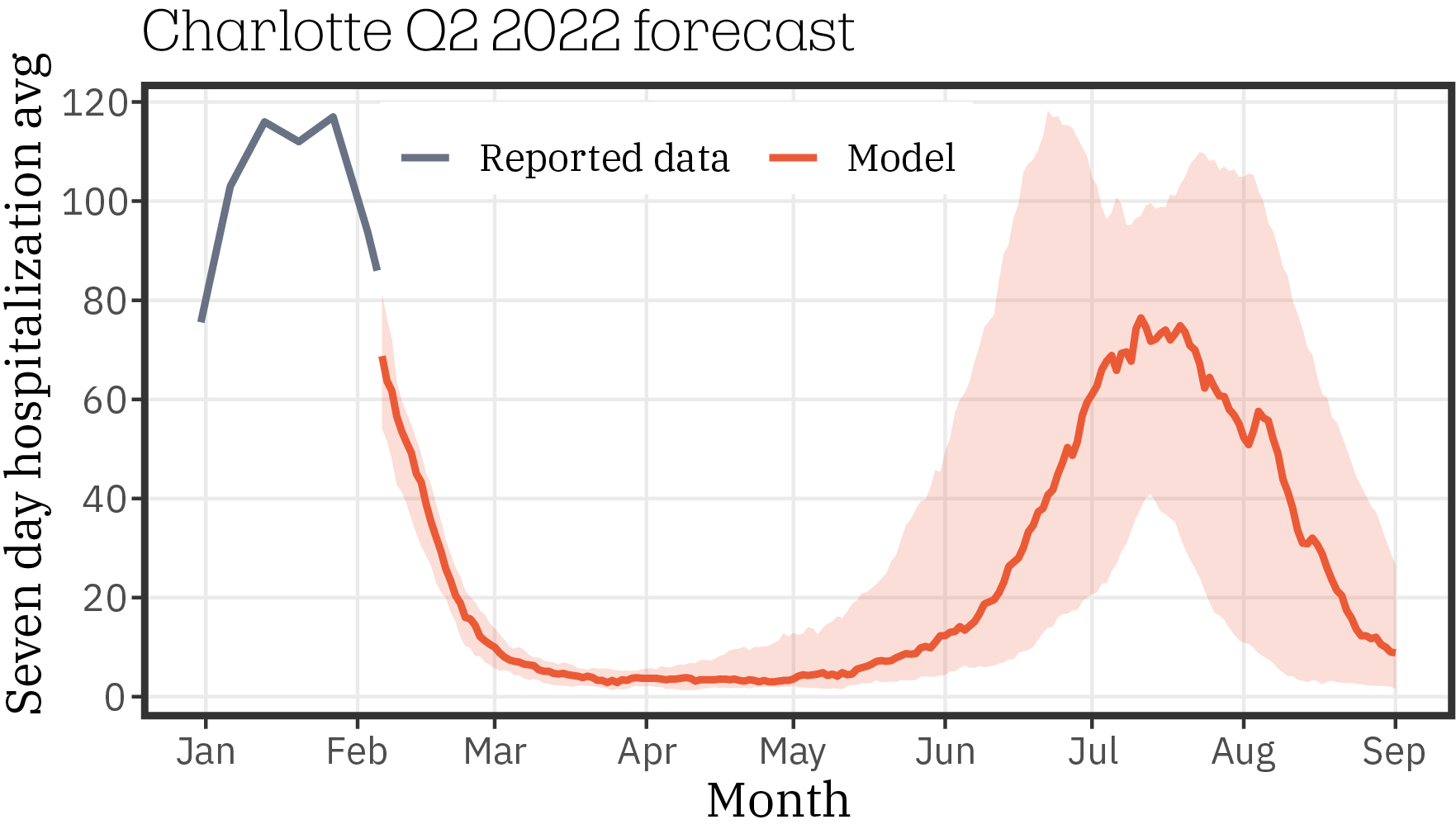
Chicago
The city of Chicago is in the northeast region of our seasonality analysis. From the beginning of March to the middle of May we expect hospitalizations to stay the same. In June, we expect hospitalizations to begin increasing until the fall. For the next three months, we expect hospitalizations to average 30 per day. Based on the CDC COVID-19 Community Levels, Chicago falls into the low transmission category for the next three months.
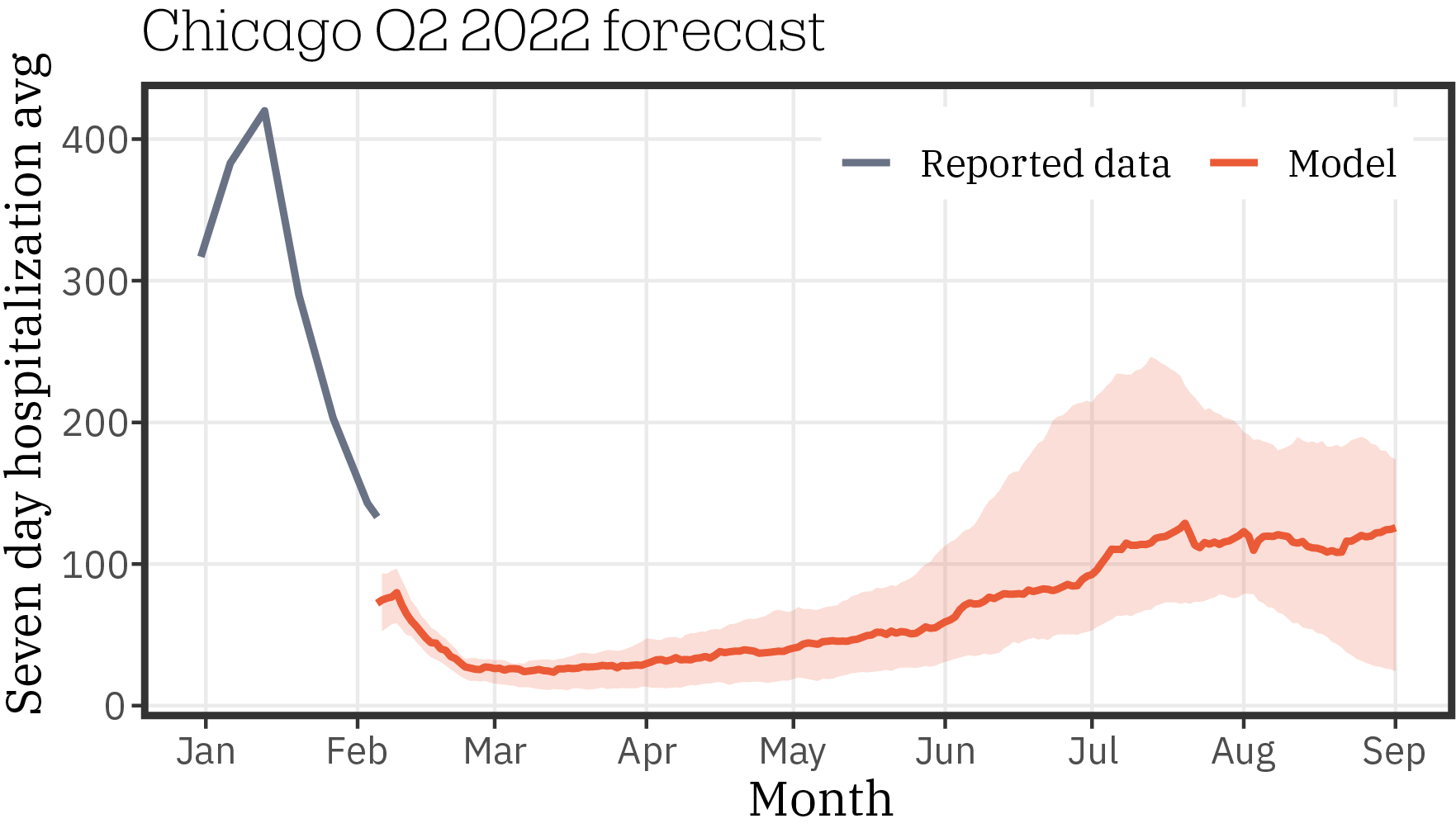
Dallas
The city of Dallas is in the southwest region of our seasonality analysis. From the beginning of March to early April we expect hospitalizations to be decreasing. In June, we expect hospitalizations to begin increasing until late August before decreasing into September. For the next three months, we expect hospitalizations to average 0.42 per 100,000 individuals per day. Based on the CDC COVID-19 Community Levels, Dallas falls into the low transmission category for the next three months.
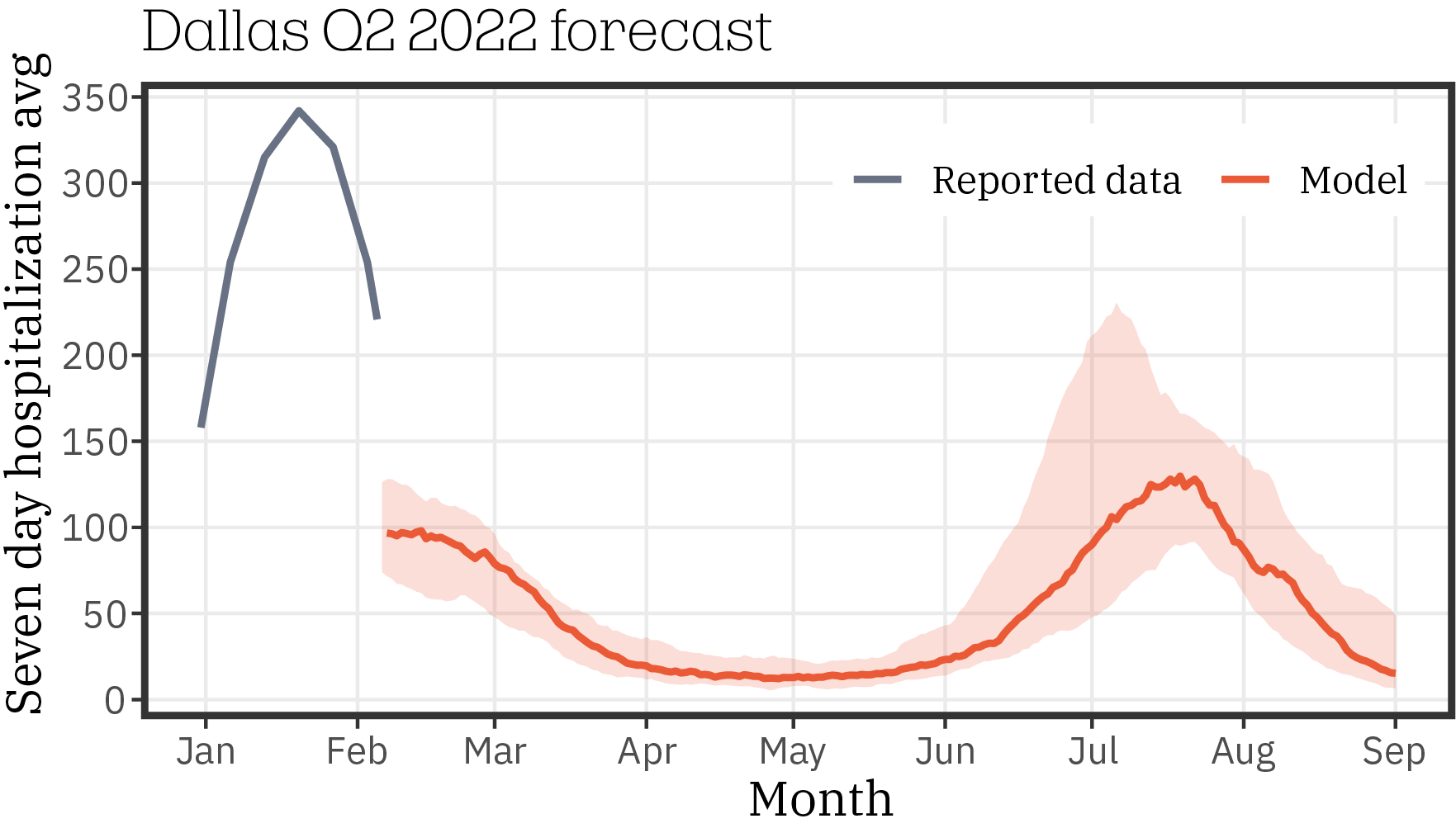
Denver
The city of Denver is in the west/midwest region of our seasonality analysis. From the beginning of March to late May we expect hospitalizations to stay the same. In June, we expect hospitalizations to begin increasing through September. For the next three months, we expect hospitalizations to average 5 per day. Based on the CDC COVID-19 Community Levels, Denver falls into the low transmission category for the next three months.
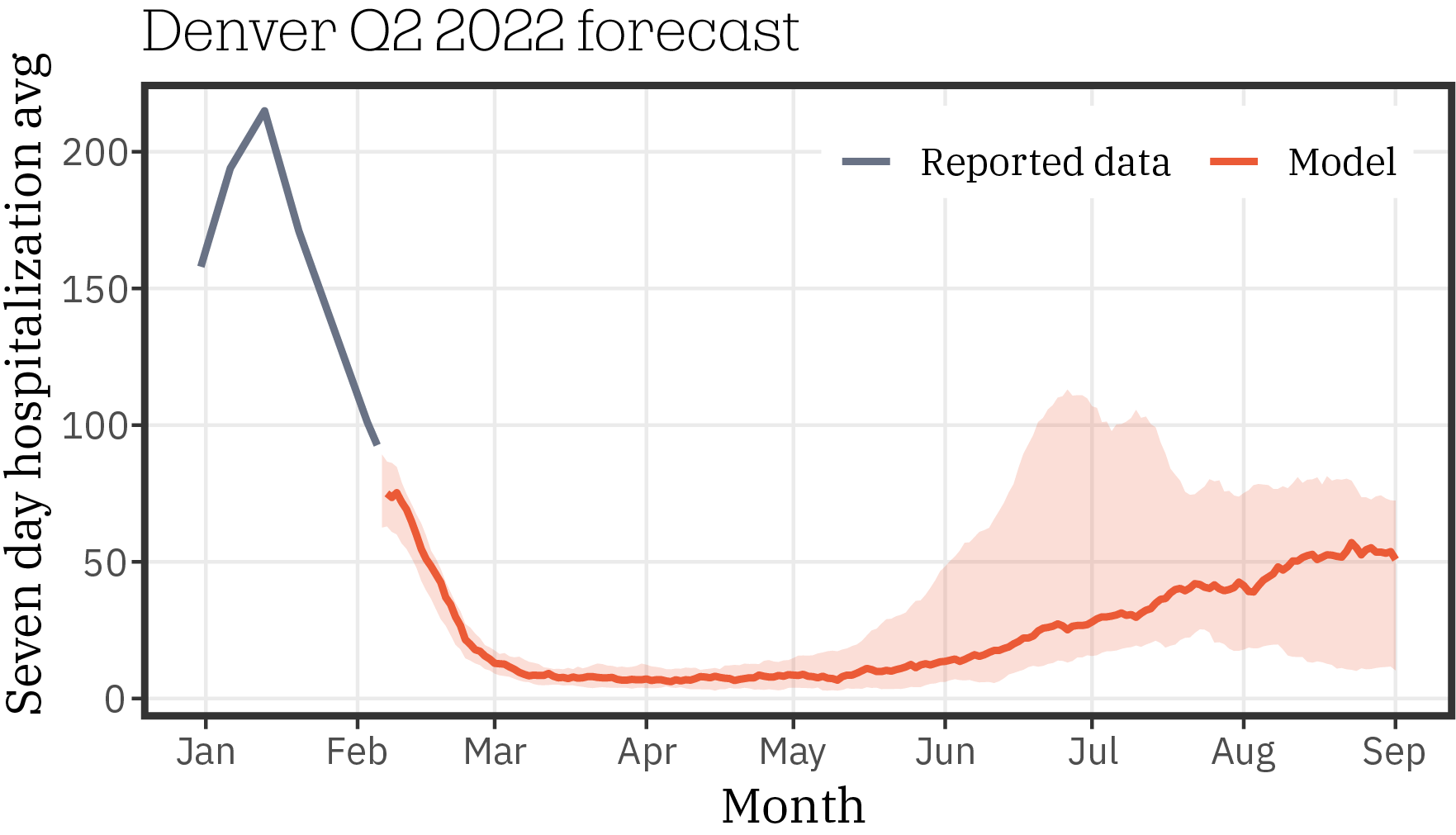
Houston
The city of Houston is in the southwest region of our seasonality analysis. From the beginning of March to late May we expect hospitalizations to stay the same. In June, we expect hospitalizations to begin increasing until August before decreasing through September. For the next three months, we expect hospitalizations to average 15 per day. Based on the CDC COVID-19 Community Levels, Houston falls into the low transmission category for the next three months.
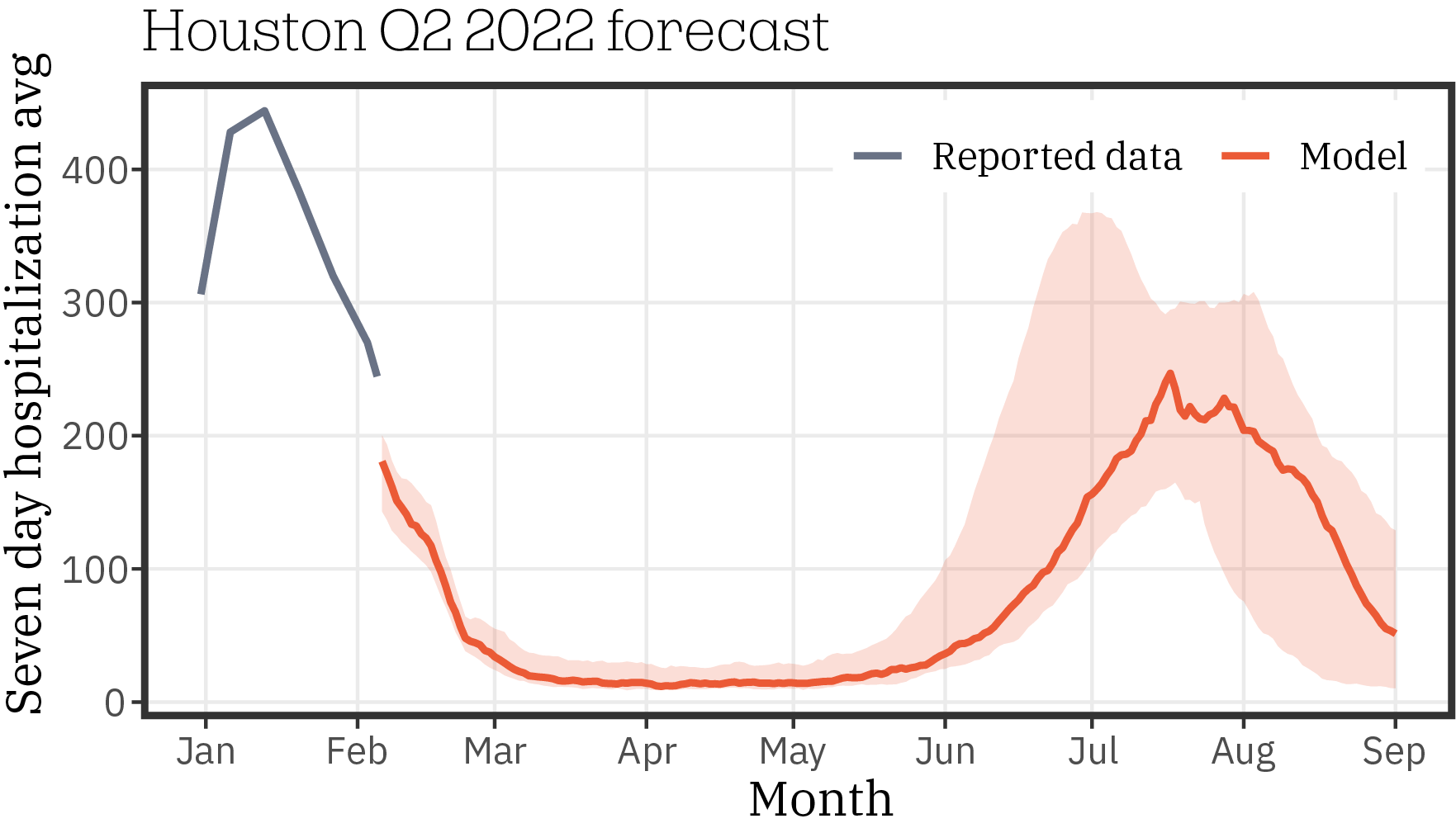
Las Vegas
The city of Las Vegas is in the southwest region of our seasonality analysis. From the beginning of March to early June we expect hospitalizations to stay the same. In June, we expect hospitalizations to begin increasing until early August before decreasing through September. For the next three months, we expect hospitalizations to average 2 per day. Based on the CDC COVID-19 Community Levels, Las Vegas falls into the low transmission category for the next three months.
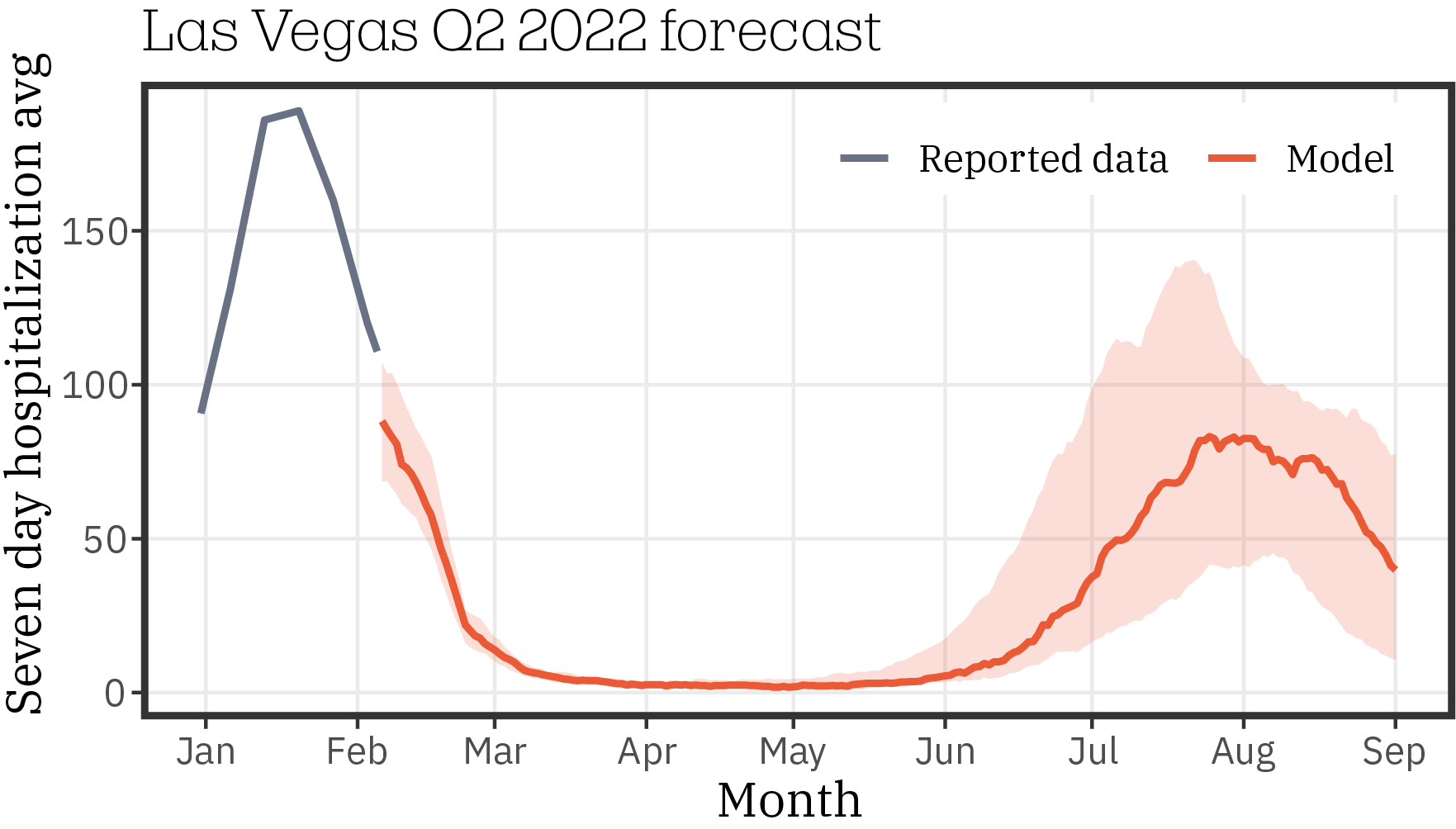
Nashville
The city of Nashville is in the southeast region of our seasonality analysis. From the beginning of March to early April we expect hospitalizations to be decreasing then holding steady until early June. In June, we expect hospitalizations to begin increasing until a peak in late July, before decreasing again through September. For the next three months, we expect hospitalizations to average 8 per day. Based on the CDC COVID-19 Community Levels, Nashville falls into the low transmission category for the next three months.
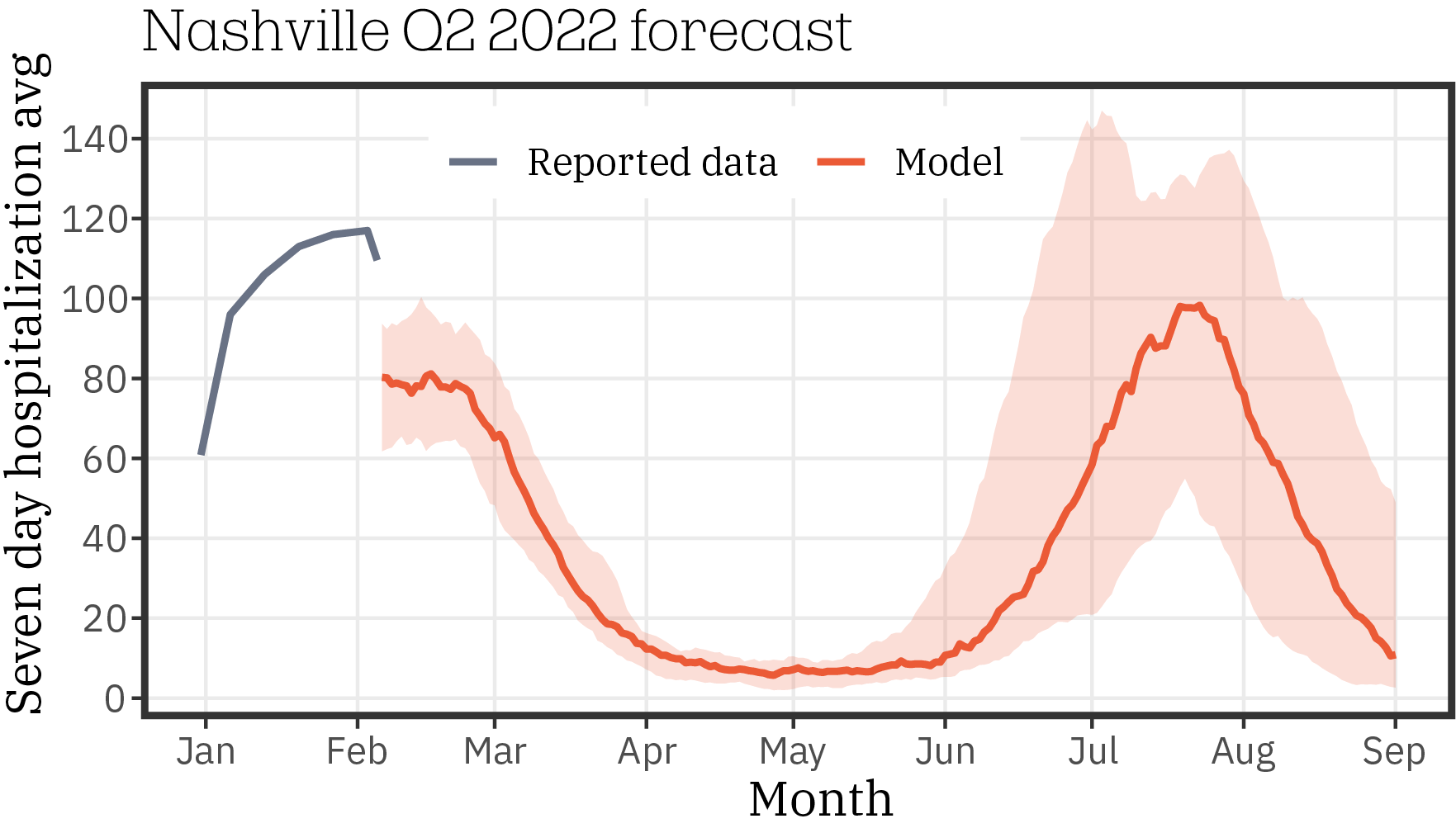
New Orleans
The city of New Orleans is in the southeast region of our seasonality analysis. From the beginning of March to late May we expect hospitalizations to be gradually increasing. In June we expect hospitalizations to begin increasing sharply until late July before they fall again through September. For the next three months, we expect hospitalizations to average 20 per day. Based on the CDC COVID-19 Community Levels, New Orleans falls into the medium transmission category for the next three months.
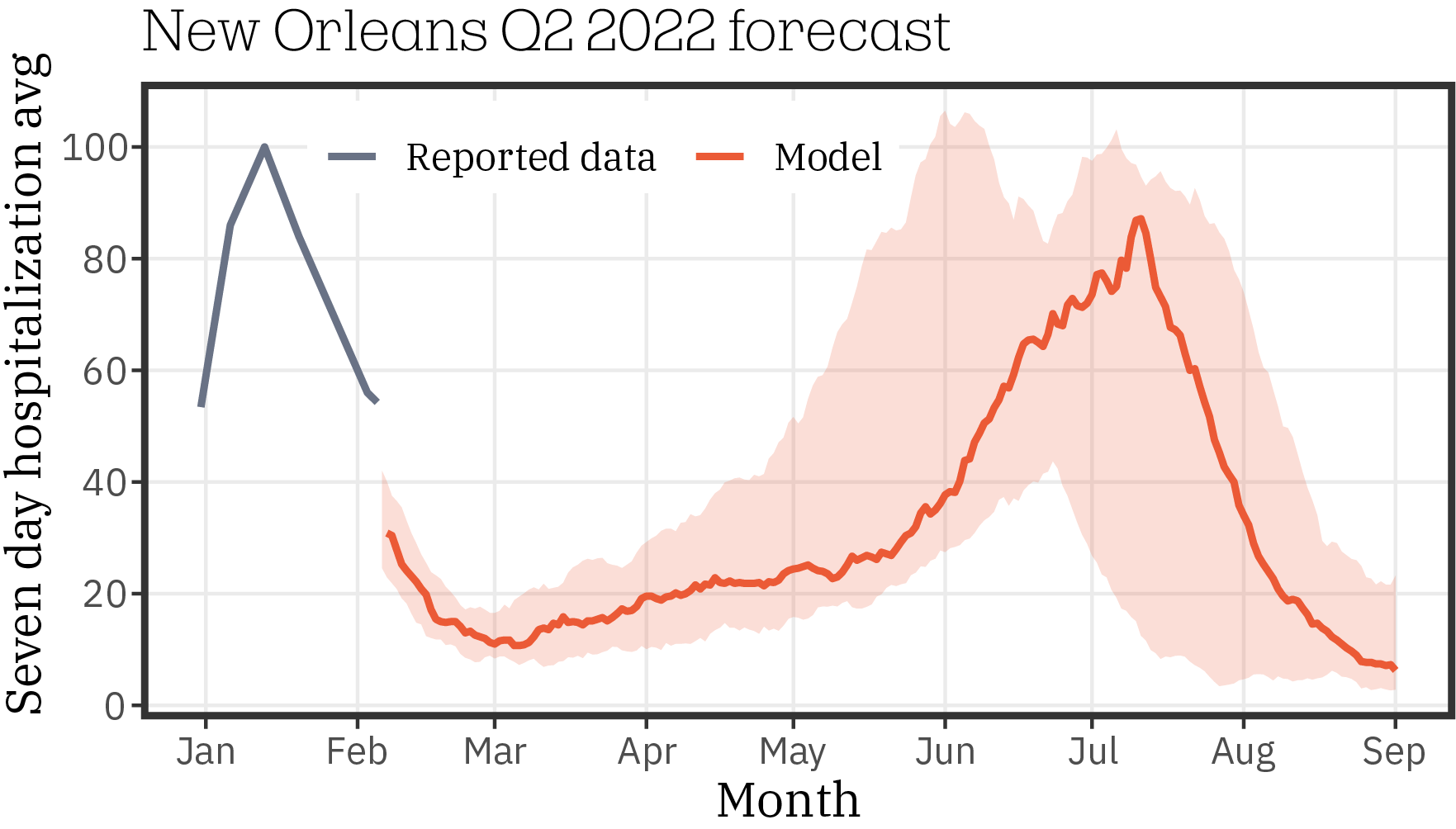
New York
The city of New York is in the northeast region of our seasonality analysis. From the beginning of March to late June we expect hospitalizations to stay the same. In July, we expect hospitalizations to begin moderately increasing through the fall. For the next three months, we expect hospitalizations to average 1 per day. Based on the CDC COVID-19 Community Levels, New York falls into the low transmission category for the next three months.
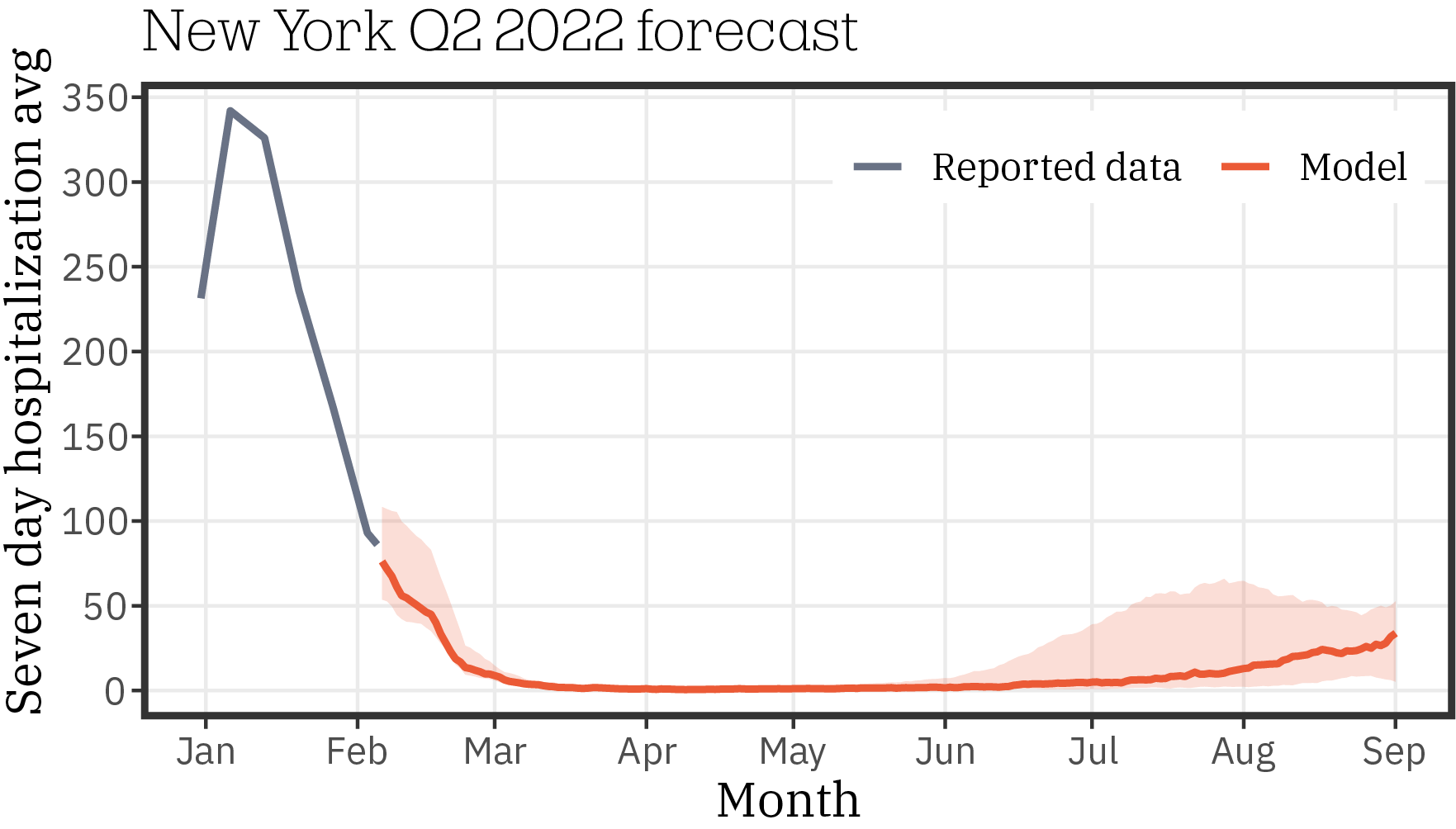
Orlando
The city of Orlando is in the southeast region of our seasonality analysis. From the beginning of March to early May we expect hospitalizations to be decreasing. In June, we expect hospitalizations to begin increasing until August, before decreasing again through September. For the next three months, we expect hospitalizations to average 20 per day. Based on the CDC COVID-19 Community Levels, Orlando falls into the low transmission category for the next three months.
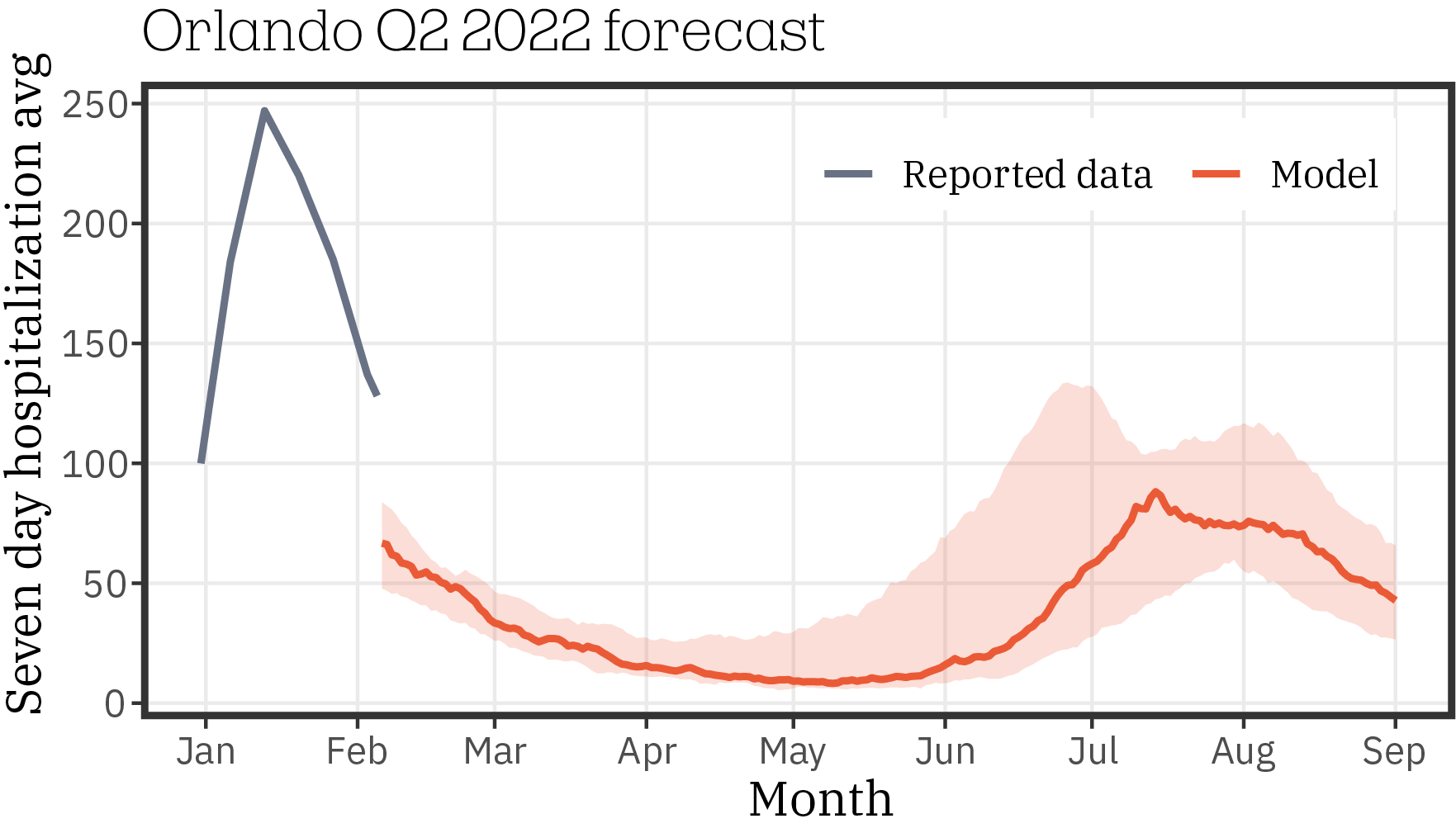
Philadelphia
The city of Philadelphia is in the northeast region of our seasonality analysis. From the beginning of March to late May we expect hospitalizations to stay the same. In June, we expect hospitalizations to begin increasing through the fall. For the entire projected period, we expect hospitalizations to average 5 per day. Based on the CDC COVID-19 Community Levels, Philadelphia falls into the low transmission category for the next three months.
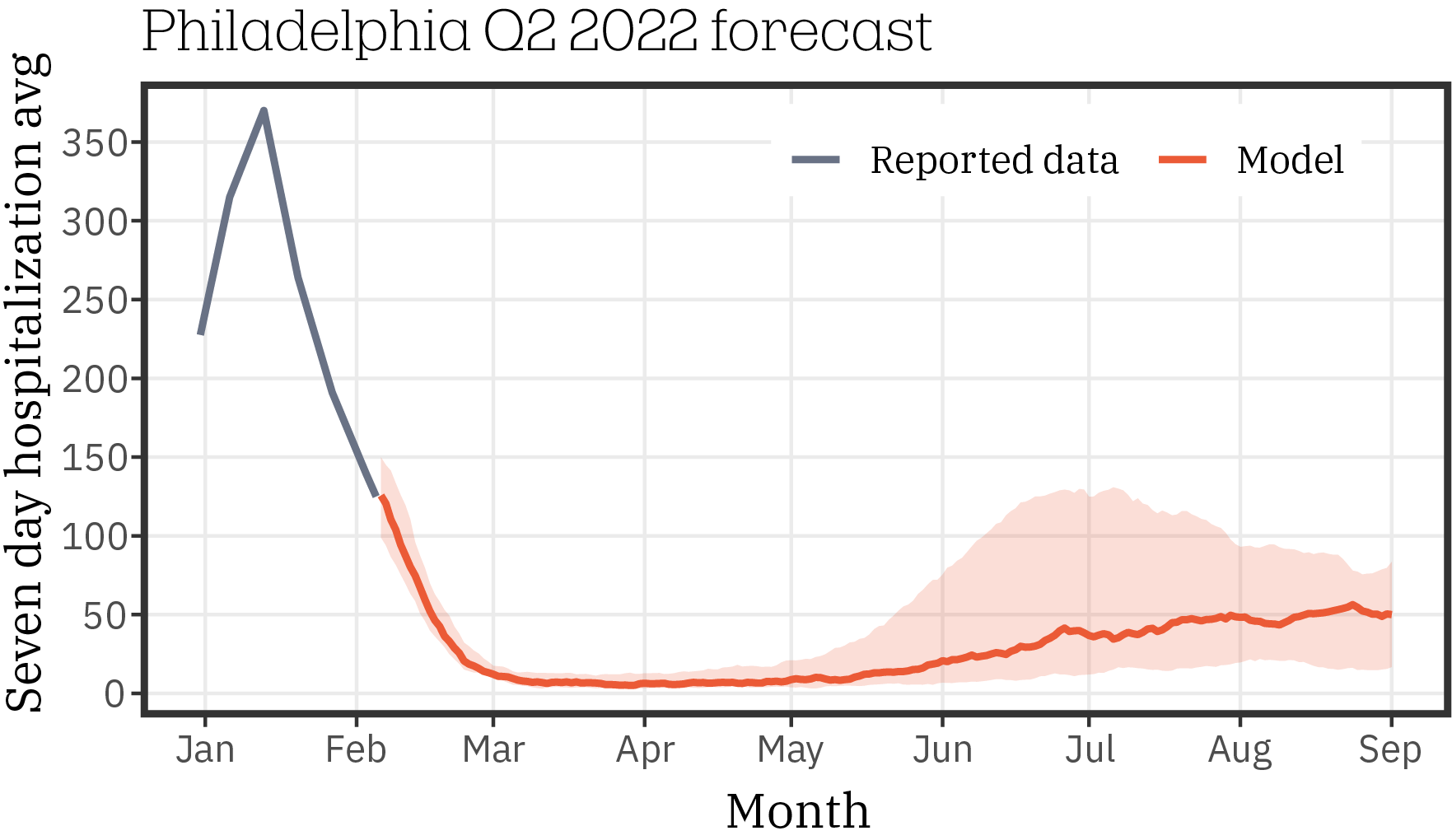
Sacramento
The city of Sacramento is in the west/midwest region of our seasonality analysis. From the beginning of March to May we expect hospitalizations to stay the same. In June, we expect hospitalizations to begin increasing until September. For the next three months, we expect hospitalizations to average 2 per day. Based on the CDC COVID-19 Community Levels, Sacramento falls into the low transmission category for the next three months.
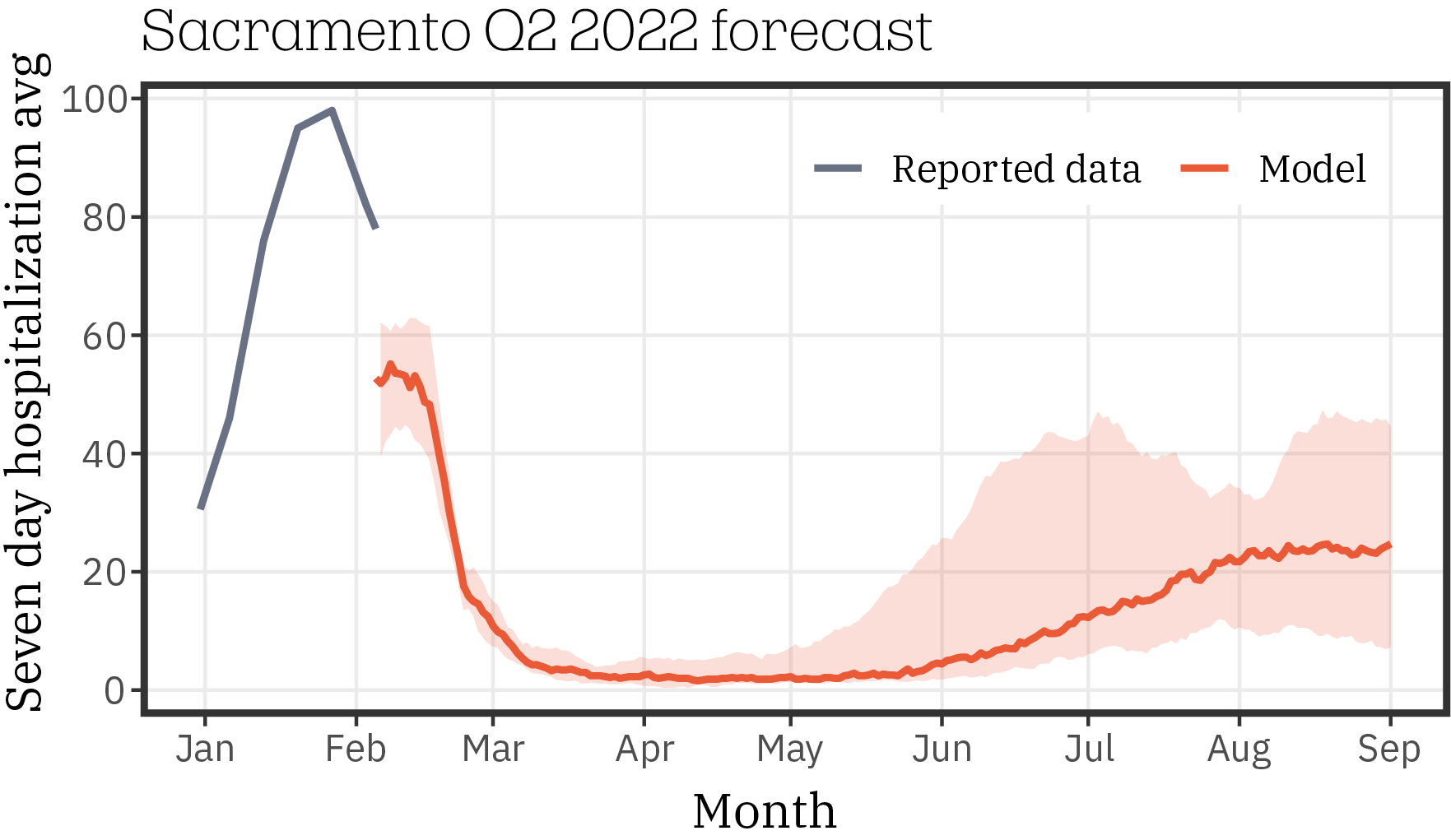
San Antonio
The city of San Antonio is in the southwest region of our seasonality analysis. From the beginning of March to mid-May we expect hospitalizations to stay the same. In June, we expect hospitalizations to begin increasing until August before decreasing through September. For the next three months, we expect hospitalizations to average 5 per day. Based on the CDC COVID-19 Community Levels, San Antonio falls into the low transmission category for the next three months.
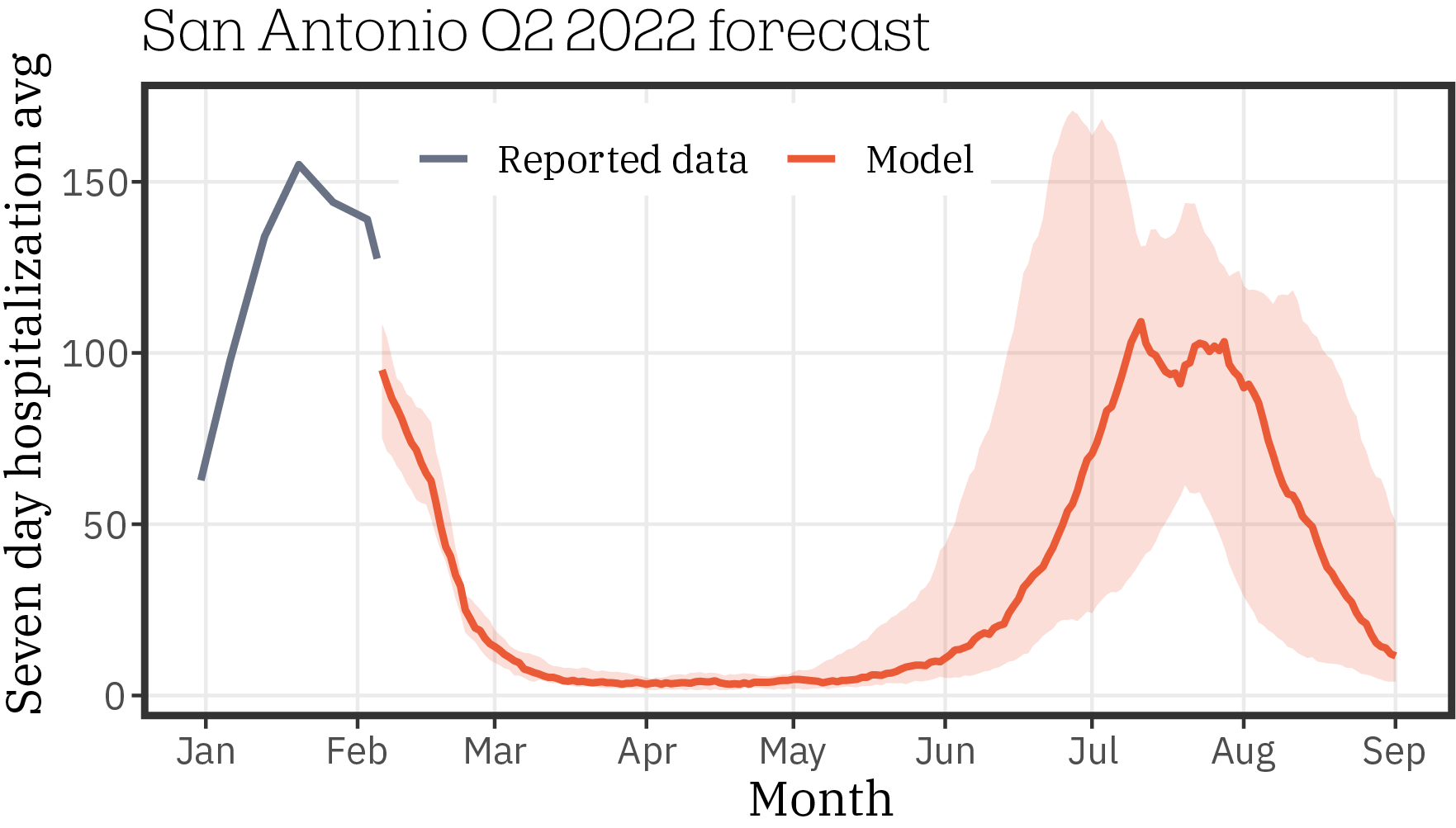
San Diego
The city of San Diego is in the west/midwest region of our seasonality analysis. From the beginning of March to June we expect hospitalizations to stay the same. In late-June we expect hospitalizations to begin increasing through September. For the next three months, we expect hospitalizations to average 5 per day. Based on the CDC COVID-19 Community Levels, San Diego falls into the low transmission category for the next three months.
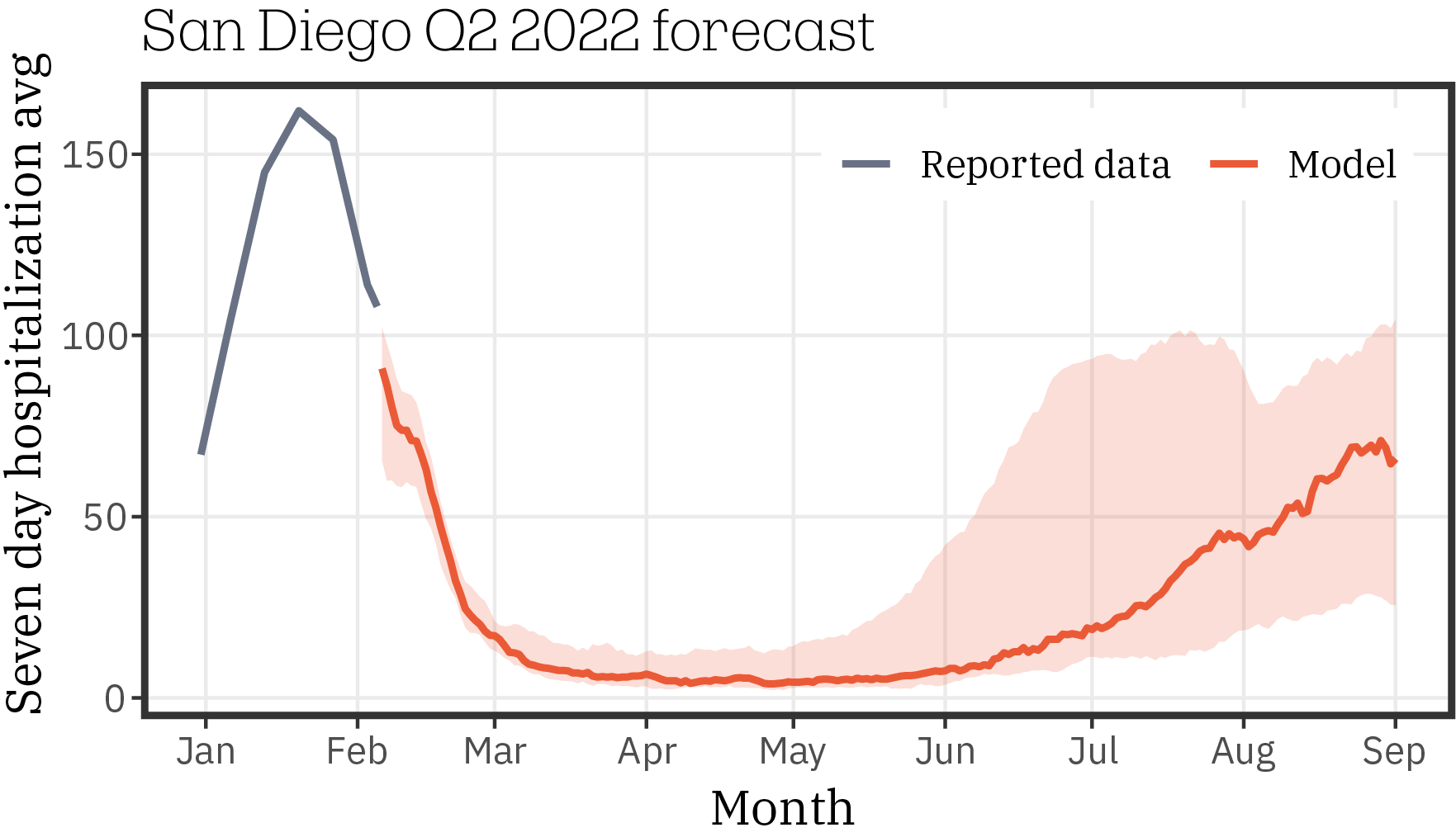
San Francisco
The city of San Francisco is in the west/midwest region of our seasonality analysis. From the beginning of March to April we expect hospitalizations to stay the same. In mid-April, we expect hospitalizations to begin increasing until July before decreasing through September. For the next three months, we expect hospitalizations to average 40 per day. Based on the CDC COVID-19 Community Levels, San Francisco falls into the low transmission category for the next three months.
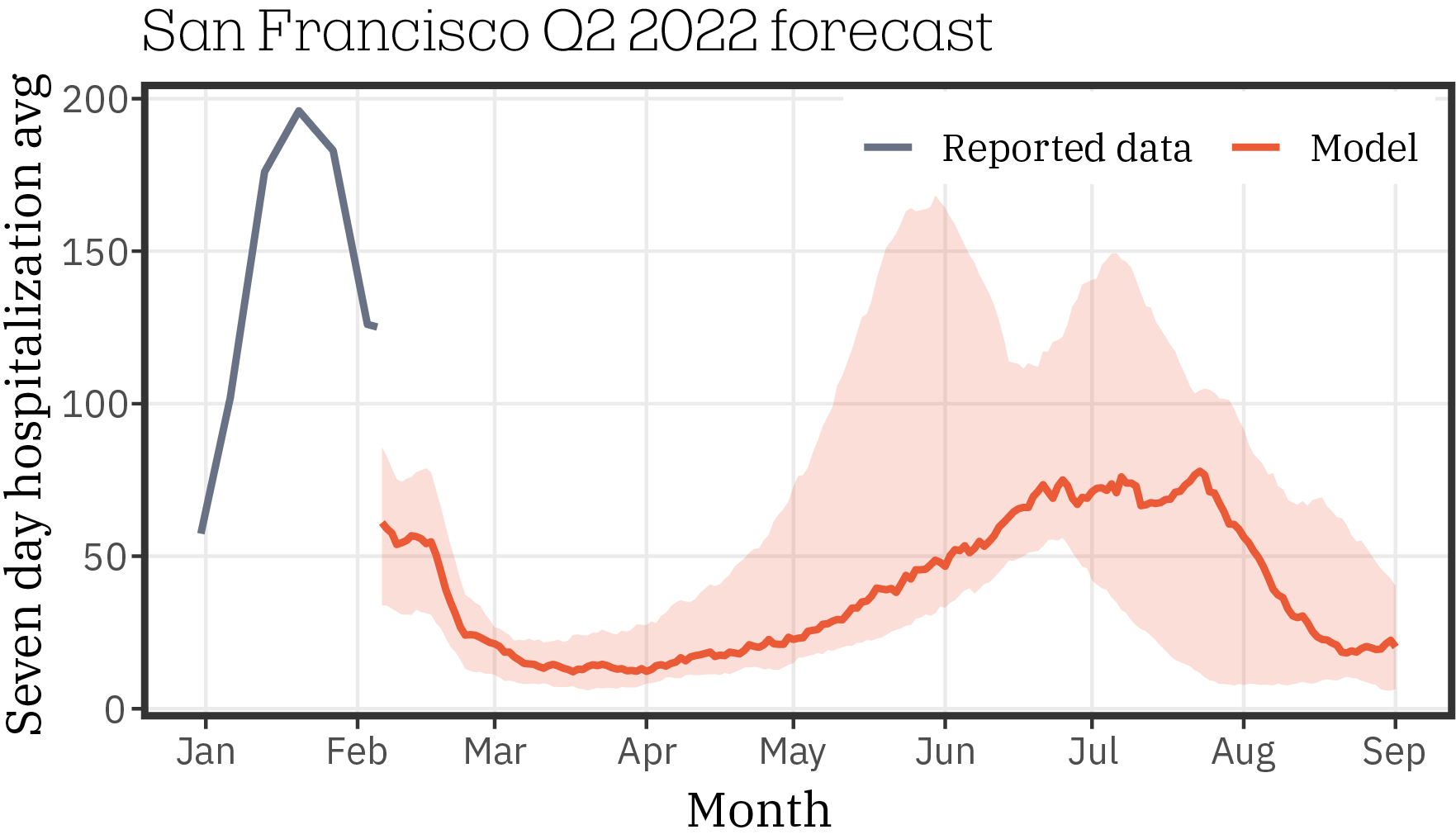
Washington, DC
The city of Washington, DC is in the northeast region of our seasonality analysis. From the beginning of March to early April we expect hospitalizations to stay the same. In mid-April, we expect hospitalizations to begin increasing through July then holding steady until September. For the next three months, we expect hospitalizations to average 50 per day. Based on the CDC COVID-19 Community Levels, Washington, DC falls into the low transmission category for the next three months.
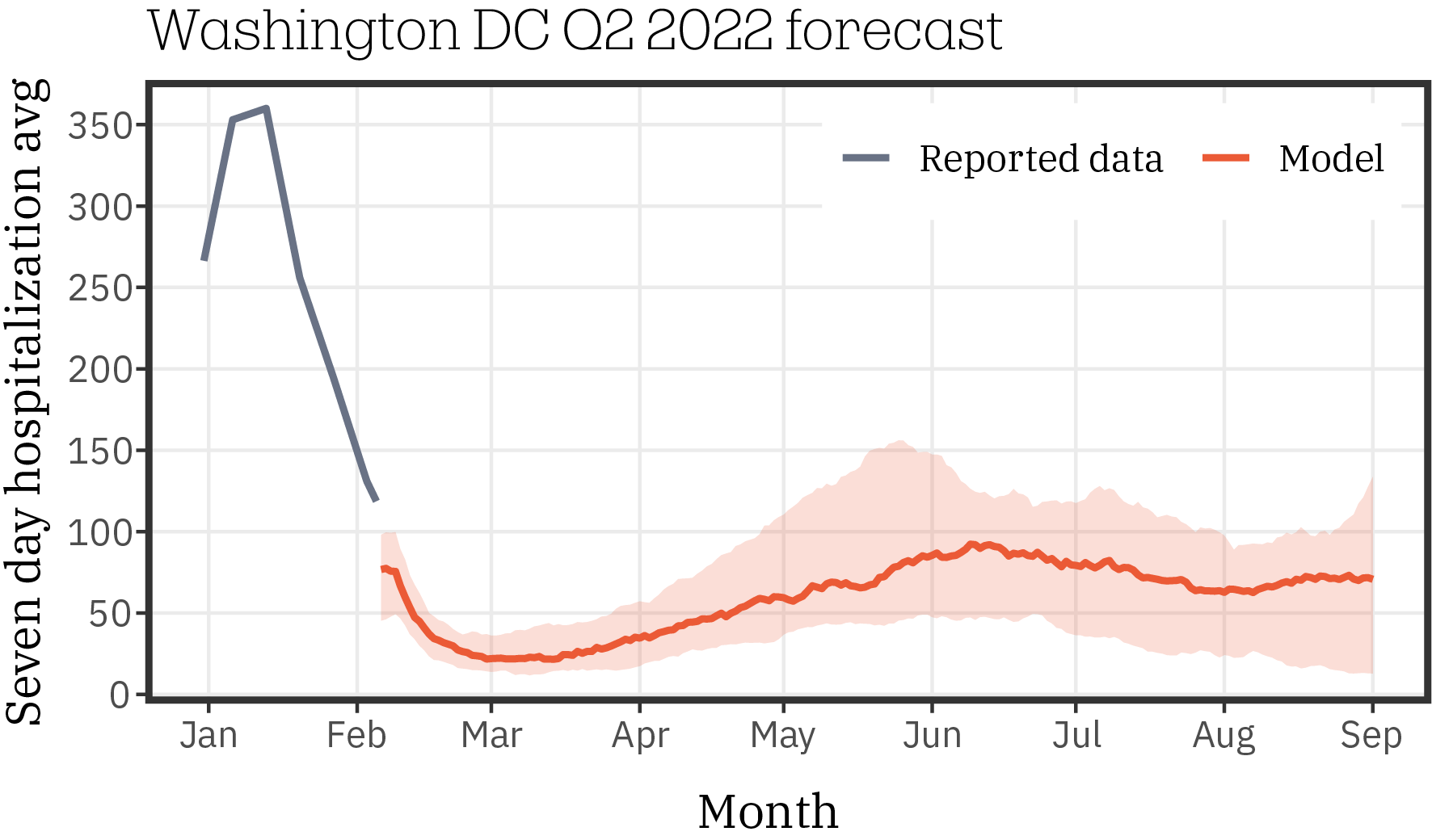
Learn more about the technology behind this forecast and how customers use it to make better decisions.
